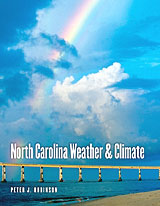 |
In the summer of 1587, somewhat more than 100 English settlers staggered ashore at Roanoke Island in the Outer Banks — and into the teeth of the worst drought to strike the region in more than 400 years.
It was, patently, a bad time to relocate to the New World. Game was scarce; the surrounding woods were a tinderbox; crops refused to grow. And the settlers — by now starving and doubtless murmuring, “Who knew?” — must have pined for England, its easy living, its eel pies and bottomless tankards of ale.
But if the fate of the “Lost Colony” remains a big question mark, the capriciousness of North Carolina’s climate and weather are familiar to anyone who’s lived here for more than a few days. The range alone — the mountains’ snow and occasional bitter winter cold; the languorous, extended heat and humidity of the coastal plain; the fierce wind of the Outer Banks; the ice storms endured by Piedmont residents — makes the state’s atmospheric comings and goings a bookworthy subject.
And in North Carolina Weather and Climate (University of North Carolina Press, 2005), author Peter Robinson, a native Englishman himself, has set out to make the Tar Heel State’s weather understandable to the layperson. Robinson is well-suited to the task: He served as North Carolina’s official state climatologist for many years, and since 1971, he’s taught geography and meteorology at UNC-Chapel Hill.
Robinson’s new book keeps rarefied company. To the author’s knowledge, the only other states boasting whole books about their climates are Texas and Florida. “I once met the fellow who wrote the book on Texas weather,” Robinson said in a recent phone interview. “Well, Texas is a big place, you know. He’d written 1,000 pages; had to cut it down a bit.”
In an impressive display of self-restraint, Robinson held his own tome down to 256 pages. But what a lot of ground he covers! The major elements of both global and North American weather are described in detail, with particular attention to how they influence North Carolina. The origin of wave cyclones, the meanderings of the jet stream, the interplay of the earth’s surface and the behavior of the sky, and hundreds of lesser elements are also explained.
Residents of the state’s western end will find a wealth of information on our peculiar local climate. Some of it may be surprising — such as the fact that Asheville, surrounded by mountains, actually ranks among the driest parts of the state. As weather systems bear up and over the mountains — especially the moisture-laden fronts from the Gulf of Mexico — they tend to drop their moisture on the mountains’ windward side, leaving little to fall on Asheville. The city’s annual precipitation (37.5 inches, according to Robinson) seems arid compared to neighboring Lake Toxaway’s positively tropical 91.2 inches. (It seems worth noting here that other local sources, including the city’s own Web site, give significantly higher figures for Asheville.)
Still, we can all feel a frisson of pride on learning that a record low (minus 34 degrees Fahrenheit) was recorded at the summit of Mount Mitchell in January 1985, or that 60 inches of wet snow fell on Mount Pisgah in May 1992. By any standard, these are impressive numbers. Robinson also explains how the mountain topography gave rise to the apple industry, and why the region is rife with frost pockets and thermal inversions.
Among the book’s best features are its many sidebars highlighting notable weather events in the state: the one-two punch of hurricanes Dennis and Floyd in 1999; the “Storm of the Century” in March 1993; the record cold that coincided with Ronald Reagan’s inauguration in January 1985; the wrath of Hurricane Hazel in 1954; the devastating mountain floods of 1916. Other events may be less familiar (a gold star to anyone who remembers the ozone alert of June 23, 2003) but are no less interesting.
Contemporary trends also get their due. Robinson describes air pollution’s effects on weather and visibility as well as the likely role of climate change in North Carolina’s future. Surprisingly, the American Southeast is one of only two spots around the globe (the other is in China) that didn’t demonstrate a net rise in temperature over the last century, the author reports.
If North Carolina Weather and Climate has a major fault, it’s the volume’s textbookish appearance and format, likely to nudge anyone with a public-school background dangerously close to a fit of yawns. The flip side, however, is ease of access: The book’s graphs and charts are abundant and clear, its chapters well-organized.
The book also suffers, albeit in a minor way, from allocating too much space to photographs that illustrate nothing in particular: radar domes and paint-peeled rain gauges sitting in weedy fields scattered across the state.
In an age of scrolling heat indices, Doppler radar and “weather on the eights,” it’s tempting to believe that we’re a far more weather-savvy nation than ever before. Robinson, however, disagrees.
“Judging by the number of people who drive around police barriers and into flooded rivers, we probably aren’t,” he observes. “Everybody has more information these days, but whether anybody does anything with it is another matter.”



Before you comment
The comments section is here to provide a platform for civil dialogue on the issues we face together as a local community. Xpress is committed to offering this platform for all voices, but when the tone of the discussion gets nasty or strays off topic, we believe many people choose not to participate. Xpress editors are determined to moderate comments to ensure a constructive interchange is maintained. All comments judged not to be in keeping with the spirit of civil discourse will be removed and repeat violators will be banned. See here for our terms of service. Thank you for being part of this effort to promote respectful discussion.